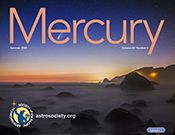Summer 2020 - Volume 49, Number 3

Table of Contents
[21] Space News
A rundown of some of the most exciting developments in space and time.
[27] Cosmic Views
See the Sun up-close, and marvel at one of the first images from the enormous camera accompanying the still-under-construction Vera C. Rubin Observatory
[29] Cataloging the Cosmos
Gaia gathers small details that lead to big insights
[36] Comet NEOWISE Adorned the Northern Skies
2020 needed a win, so the Solar System gave the Northern Hemisphere the brightest comet it’s seen in more than two decades.
Departments:
[3] Perspectives, Liz Kruesi
Summer of Science
[4] First Word, Linda Shore
On the Importance of Looking Up
[6] Annals of Astronomy, Clifford J. Cunningham
Trip Through the Solar System in 1460
[8] Astronomer’s Notebook, Jennifer Birriel
The Eratosthenes Experiment
[10] Armchair Astrophysics, Christopher Wanjek
Dark Matter Appears to be a Smooth Operator
[12] Research Focus, M. Katy Rodriguez Wimberly
Why Have Our Galactic Neighbors Lost Their Star-forming Oomph?
[15] Education Matters, Brian Kruse
Infecting Students with Enthusiasm for Astrobiology
[17] A Little Learning, C. Renée James & Scott T. Miller
This Doesn’t Bode Well
[42] Reflections, Liz Kruesi
Aurora Above Antarctica
Cataloging the Cosmos (Feature)
By Steve Murray
The European Space Agency (ESA) set a big task for Gaia when it launched the space telescope in 2013: measuring over one billion stars in the Milky Way with unprecedented accuracy. The spacecraft has long since passed that achievement; Gaia’s next data release, its third, will contain information about the positions, velocities, luminosities, and colors of almost double that number of stars. The growing trove of data has already generated fundamental new discoveries about our galaxy and, in 2020, the pace of that productivity is accelerating.
Comet NEOWISE Adorned the Northern Skies (Feature)
By Liz Kruesi
On March 27, 2020, the NEOWISE space mission’s automated data-sifting program flagged a dozen images with an object of interest. A few days later, several telescopes across the world confirmed the object was a comet, and it earned its formal name: Comet C/2020 F3 (NEOWISE). Those further observations also showed the comet would get close to the Sun, just outside Mercury’s orbit. The comet swung closest to the Sun in early July, and it became the brightest comet the Northern Hemisphere has seen in decades. Observers — both professional and amateur — around the world tracked and studied how Comet NEOWISE brightened and evolved.
Swing by the Sun (Cosmic Views)
By Liz Kruesi
The Solar Orbiter spacecraft spied mini solar flares, surface explosions some million times smaller than typical solar flares erupting off the Sun.
Accessing Mercury Magazine
Published since 1972, Mercury Magazine is now published four times a year for ASP Members and Institutional Subscribers. The Mercury Archives offer a table of contents for each of the digital issues going back to 2007. Members and Subscribers have access to the complete digital library of the full magazines.
ASP Members simply Log In to access all full digital issues through the MyASP Portal.
Not an ASP Member? Join today to enjoy a full year subscription, an archive of digital issues since 2007, as well as other benefits.
Institutional Subscribers must access the full library of digital issues through your Institution.
Mercury now has a voice beyond its Members as we launch Mercury Online, featuring our recognized columnists, current space news, and more in a new and up-to-date blog format.
"We live in turbulent yet exciting times, so it is our hope that Mercury Online will showcase humanity's drive to explore by delivering high-quality articles for members and nonmembers alike." — Ian O'Neill, former Editor, Mercury magazine and Mercury Online
